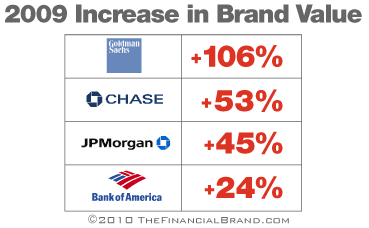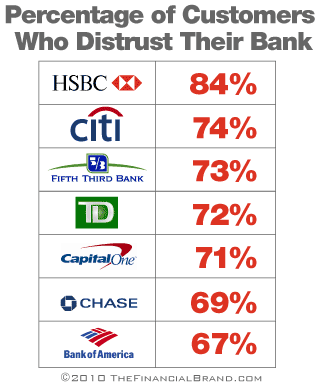Big bank brand values rise in 2009
Brand Finance, a independent brand valuation consultancy, says that the top U.S. bank brands recovered during 2009, with an overall increase in brand value of +29%. According to Brand Finance, BofA saw its brand value grow to $26.1 billion, up by +24% over 2008.
Reality Check: These guys had the value of their brands kicked to the ground in 2008. The percentage gains in 2009 may look impressive, but many of the world’s biggest bank brands are still worth a lot less than they were pre-meltdown, and some are still on their knees.
The Brand Finance study tries to quantify the price premium each bank can command for its products and services. The assumption is that Bank X has a stronger brand than Bank Y if Bank X is able to charge more for the same product or service.
Most studies, including this one from Brand Finance, attempt to quantify the financial value of brands while ignoring what those brands are really all about — consumer’s feelings, perceptions and goodwill.
Key Insight: The power of a brand’s profit potential hinges entirely on the degree of influence the brand has in consumers’ purchasing decisions.
If the value of brands was determined by how much people trusted them, these types of studies would tell a markedly different story about banks. Like this next study…

Move the Needle from Attrition to Acquisition
Vericast’s 2024 Financial TrendWatch explores seven of today’s most critical financial services trends to provide a complete view of the current loyalty landscape.
Read More about Move the Needle from Attrition to Acquisition

The Power of Localized Marketing in Financial Services
Learn how to enhance your brand’s local visibility, generate more leads, and attract more customers, all while adhering to industry regulations and compliance.
Read More about The Power of Localized Marketing in Financial Services
People trust the big banks least
A New York Times article titled “The Least-Trusted Banks in America” cites a Forrester Research study that found customers of the biggest banks in the US don’t believe their financial institution does what’s best for them, but instead does what’s best for their bottom line.
In Forrester’s annual “Customer Advocacy” study, the research firm asked 4,500 bank customers whether they agreed or disagreed with this statement: “My financial provider does what’s best for me, not just its own bottom line.”
Credit unions were the most trusted financial institutions in the U.S., with 70% of members saying their credit union looked out for their best interests. After credit unions, USAA’s bank came in second, with 64% of its members saying the organization was trustworthy.
Key Question: If a brand cannot be trusted, how can it have any value?
Banks are consistently among the least-trusted brands in Forrester’s study, but this year, HSBC broke a record. The world’s biggest bank got the lowest customer advocacy score ever reported in the U.S., down a full 10% over last year.
Meanwhile, Brand Finance says in its study that HSBC’s brand value rose 12%. Something weird is going on here. But wait, it gets even weirder…
Consumers put deposits — not trust — in banks
Consumers may say they don’t trust big banks, but that apparently isn’t enough to stop them from bringing in their deposits.
Despite near record-low APYs in 2009, the 10 largest U.S. banks posted higher deposits in the fourth quarter for the first time since 2005. JPMorgan Chase posted an 8.1% rise to $938 billion. US Bancorp said deposits rose 7.9%.
Bottom Line
According to these three studies, it seems a big bank’s brand value hinges on how well it continues to attract customers who are willing to pay a premium despite their lack of trust in the institution. Translation? Big bank brands are worth more because consumers expect to get bent but bring their business to them anyway.









